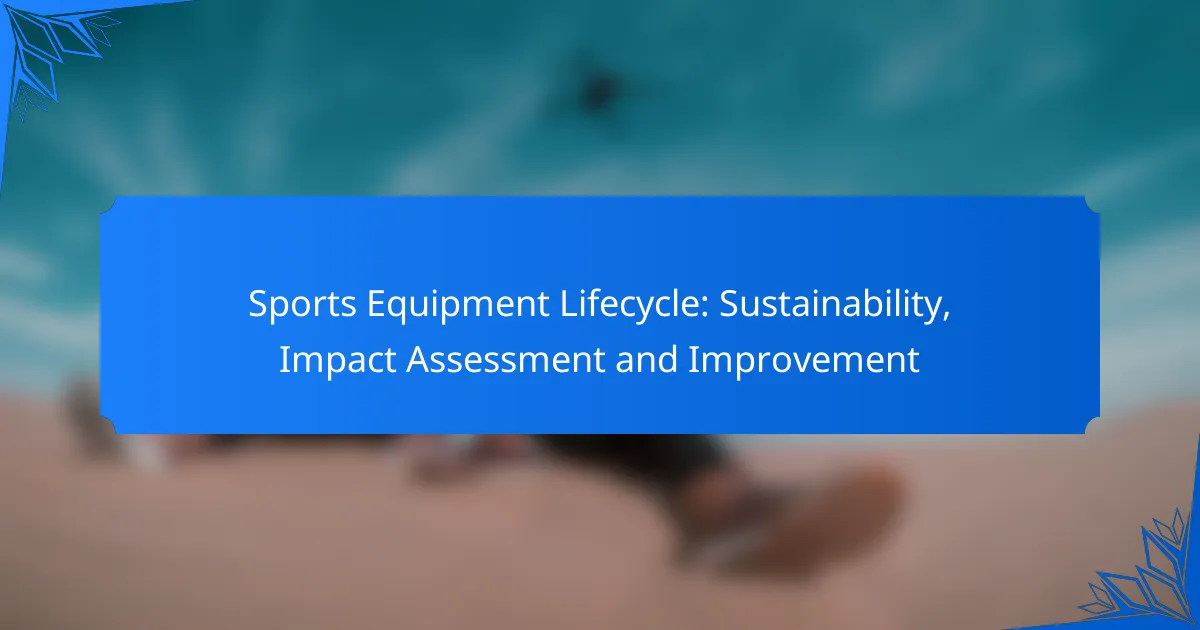The lifecycle of sports equipment plays a crucial role in determining its environmental impact, encompassing stages from production to disposal. By adopting sustainable practices such as using recycled materials and eco-friendly manufacturing processes, the sports industry can significantly reduce waste and promote a circular economy. This not only benefits the environment but also enhances brand reputation and meets the growing consumer demand for sustainable products.

What are the sustainable practices in sports equipment manufacturing?
Sustainable practices in sports equipment manufacturing focus on reducing environmental impact through the use of recycled materials, eco-friendly production processes, and ensuring product durability. These methods aim to minimize waste and promote a circular economy within the sports industry.
Use of recycled materials
The incorporation of recycled materials in sports equipment manufacturing significantly reduces the demand for virgin resources. Commonly recycled materials include plastics, metals, and textiles, which can be repurposed into new products, thereby lowering energy consumption and emissions associated with production.
Brands are increasingly sourcing recycled materials from post-consumer waste, such as plastic bottles or discarded athletic gear. For example, some companies use recycled polyester in their apparel lines, which helps divert waste from landfills while maintaining product quality.
Eco-friendly production processes
Eco-friendly production processes involve techniques that minimize environmental harm during manufacturing. This includes using water-based adhesives, reducing energy consumption, and implementing waste reduction strategies. Adopting renewable energy sources, such as solar or wind power, is also becoming more common in factories.
Manufacturers are encouraged to comply with environmental standards, such as ISO 14001, which outlines effective environmental management systems. This not only helps in reducing the carbon footprint but also enhances brand reputation among environmentally conscious consumers.
Durability and longevity of products
Focusing on durability and longevity is crucial for sustainable sports equipment. Products designed to last longer reduce the frequency of replacements, thereby minimizing waste and resource consumption. High-quality materials and robust construction techniques contribute to a longer lifespan.
Consumers should consider investing in equipment that offers warranties or guarantees, as these often indicate a commitment to durability. Additionally, brands that provide repair services or spare parts can further support sustainability by extending the life of their products.

How does the lifecycle of sports equipment impact the environment?
The lifecycle of sports equipment significantly affects the environment through various stages, including production, usage, and disposal. Each phase contributes to carbon emissions, waste generation, and resource depletion, necessitating a comprehensive assessment for sustainability improvements.
Carbon footprint analysis
Carbon footprint analysis evaluates the total greenhouse gas emissions associated with sports equipment throughout its lifecycle. This includes emissions from raw material extraction, manufacturing processes, transportation, and end-of-life disposal. For instance, producing synthetic materials often results in higher emissions compared to natural alternatives.
To reduce carbon footprints, manufacturers can adopt renewable energy sources and optimize production processes. Consumers can also make informed choices by selecting equipment with lower carbon footprints, such as those certified by recognized environmental standards.
Waste generation and disposal
Waste generation and disposal are critical concerns in the lifecycle of sports equipment. Many items end up in landfills, contributing to environmental degradation. For example, plastic-based gear can take hundreds of years to decompose, while natural materials may break down more quickly but can still create waste if not managed properly.
To mitigate waste, recycling programs and take-back initiatives are essential. Consumers should seek brands that offer recycling options or donate used equipment to extend its lifecycle and reduce landfill contributions.
Resource consumption
Resource consumption refers to the materials and energy used in the production of sports equipment. This includes raw materials like metals, plastics, and textiles, which can lead to habitat destruction and depletion of natural resources. For example, the production of a single tennis racket may require several kilograms of raw materials.
To minimize resource consumption, manufacturers can implement sustainable sourcing practices and utilize recycled materials. Consumers can also contribute by choosing products made from sustainable resources and supporting brands committed to reducing their environmental impact.

What are the benefits of sustainable sports equipment?
Sustainable sports equipment offers numerous advantages, including reduced environmental impact and improved brand reputation. By prioritizing eco-friendly materials and practices, companies can meet consumer demand while contributing to a healthier planet.
Reduced environmental impact
Using sustainable sports equipment significantly lowers the environmental footprint associated with production and disposal. This includes minimizing resource extraction, reducing greenhouse gas emissions, and decreasing waste in landfills.
For example, equipment made from recycled materials or sustainably sourced wood can cut down on the energy and resources needed for manufacturing. Brands can also implement take-back programs to recycle old gear, further reducing their impact.
Enhanced brand reputation
Companies that adopt sustainable practices often enjoy a stronger brand reputation among consumers. By demonstrating a commitment to environmental responsibility, brands can differentiate themselves in a crowded market.
Positive public perception can lead to increased customer loyalty and attract new consumers who prioritize sustainability. Brands like Patagonia and Nike have successfully leveraged their eco-friendly initiatives to enhance their image and market share.
Consumer demand for eco-friendly products
There is a growing consumer demand for eco-friendly sports equipment, driven by increased awareness of environmental issues. Many athletes and fitness enthusiasts prefer products that align with their values regarding sustainability.
Brands that offer sustainable options can tap into this market trend, potentially increasing sales. Conducting surveys or market research can help identify specific consumer preferences and inform product development strategies.

How can sports brands improve equipment sustainability?
Sports brands can enhance equipment sustainability by adopting eco-friendly practices throughout the product lifecycle. This includes using sustainable materials, implementing recycling programs, and focusing on energy-efficient manufacturing processes.
Implementing circular economy principles
Adopting circular economy principles involves designing products for longevity, repairability, and recyclability. Brands can create take-back programs that encourage consumers to return old equipment for recycling or refurbishment, reducing waste.
For example, offering discounts on new purchases when customers return their used gear can incentivize participation. Additionally, using modular designs allows for easy upgrades, extending the product’s life and minimizing environmental impact.
Investing in sustainable technologies
Investing in sustainable technologies is crucial for reducing the environmental footprint of sports equipment. This includes utilizing renewable energy sources in manufacturing and exploring innovative materials such as bio-based plastics or recycled fibers.
Brands can also focus on improving the efficiency of production processes to lower energy consumption. For instance, adopting 3D printing technology can reduce material waste and allow for on-demand production, minimizing excess inventory.
Collaborating with environmental organizations
Collaboration with environmental organizations can enhance a brand’s sustainability efforts by providing expertise and resources. Partnering with NGOs can help brands develop better recycling initiatives and raise awareness about sustainable practices among consumers.
Brands should consider participating in industry-wide sustainability initiatives, which can amplify their impact. For example, joining groups that focus on reducing plastic waste in sports can lead to shared resources and collective action for greater change.

What frameworks exist for assessing the sustainability of sports equipment?
Several frameworks exist to evaluate the sustainability of sports equipment, focusing on environmental impact and resource efficiency. These frameworks help manufacturers and consumers understand the lifecycle effects of their products and make informed decisions.
Life Cycle Assessment (LCA)
Life Cycle Assessment (LCA) is a systematic process for evaluating the environmental impacts of a product throughout its entire lifecycle, from raw material extraction to disposal. It considers various factors, including energy consumption, greenhouse gas emissions, and resource depletion.
In practice, LCA involves several stages: goal definition, inventory analysis, impact assessment, and interpretation. For sports equipment, this means assessing materials like plastics, metals, and textiles, as well as the manufacturing processes and transportation methods used.
When conducting an LCA, it is crucial to use reliable data and consider regional differences, as local regulations and environmental conditions can significantly affect sustainability outcomes. For example, a tennis racket made from sustainably sourced wood may have a lower impact than one made from synthetic materials.
ISO 14001 standards
ISO 14001 is an international standard that outlines the requirements for an effective environmental management system (EMS). It helps organizations improve their environmental performance through more efficient use of resources and reduction of waste.
For sports equipment manufacturers, implementing ISO 14001 can lead to better compliance with environmental regulations and enhanced reputation among consumers. This standard encourages continuous improvement and can be integrated with other management systems, such as quality or safety standards.
To achieve ISO 14001 certification, companies must demonstrate commitment to environmental management through regular audits, employee training, and stakeholder engagement. This can result in cost savings and a more sustainable approach to product development, ultimately benefiting both the environment and the bottom line.

What are the emerging trends in sustainable sports equipment?
Emerging trends in sustainable sports equipment focus on reducing environmental impact through innovative materials, technology, and consumer engagement. These trends aim to enhance the lifecycle of sports gear while promoting eco-friendly practices among manufacturers and users alike.
Biodegradable materials
Biodegradable materials are becoming increasingly popular in the production of sports equipment, allowing for a reduced environmental footprint. These materials can break down naturally over time, minimizing landfill waste. Common examples include bioplastics made from corn starch or other organic sources, which can replace traditional plastics in items like tennis balls and yoga mats.
When choosing biodegradable options, consider the product’s lifespan and the conditions required for proper degradation. Some materials may require industrial composting facilities to break down effectively, which may not be available in all areas.
Smart equipment with sustainability tracking
Smart sports equipment equipped with sustainability tracking features is gaining traction, helping athletes monitor their environmental impact. Devices like smart running shoes or fitness trackers can provide data on usage patterns, allowing users to make informed decisions about when to repair or replace gear. This not only extends the life of the equipment but also encourages responsible consumption.
Look for products that integrate sustainability metrics, such as carbon footprint calculations or resource usage statistics. These insights can guide consumers toward more sustainable choices and foster a culture of accountability in sports equipment usage.
Consumer education on sustainability
Educating consumers about sustainability in sports equipment is crucial for driving change in the industry. Awareness campaigns can inform athletes about the benefits of choosing eco-friendly products and the importance of proper disposal methods. Brands that prioritize transparency in their sustainability practices often attract environmentally conscious consumers.
To enhance your knowledge, seek out resources from reputable organizations that focus on sustainable practices in sports. Engaging with community initiatives or workshops can also provide valuable insights into making more responsible purchasing decisions.

